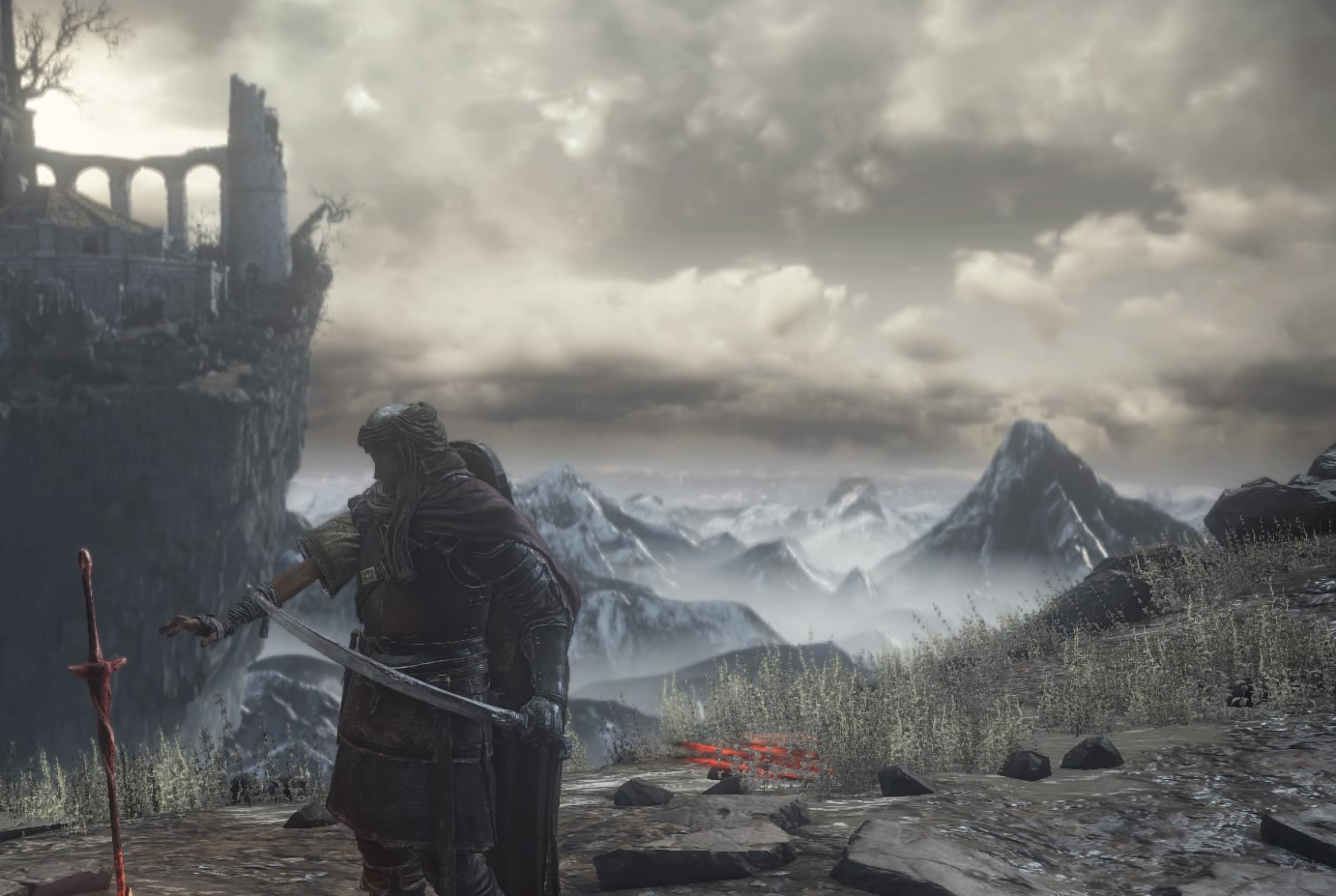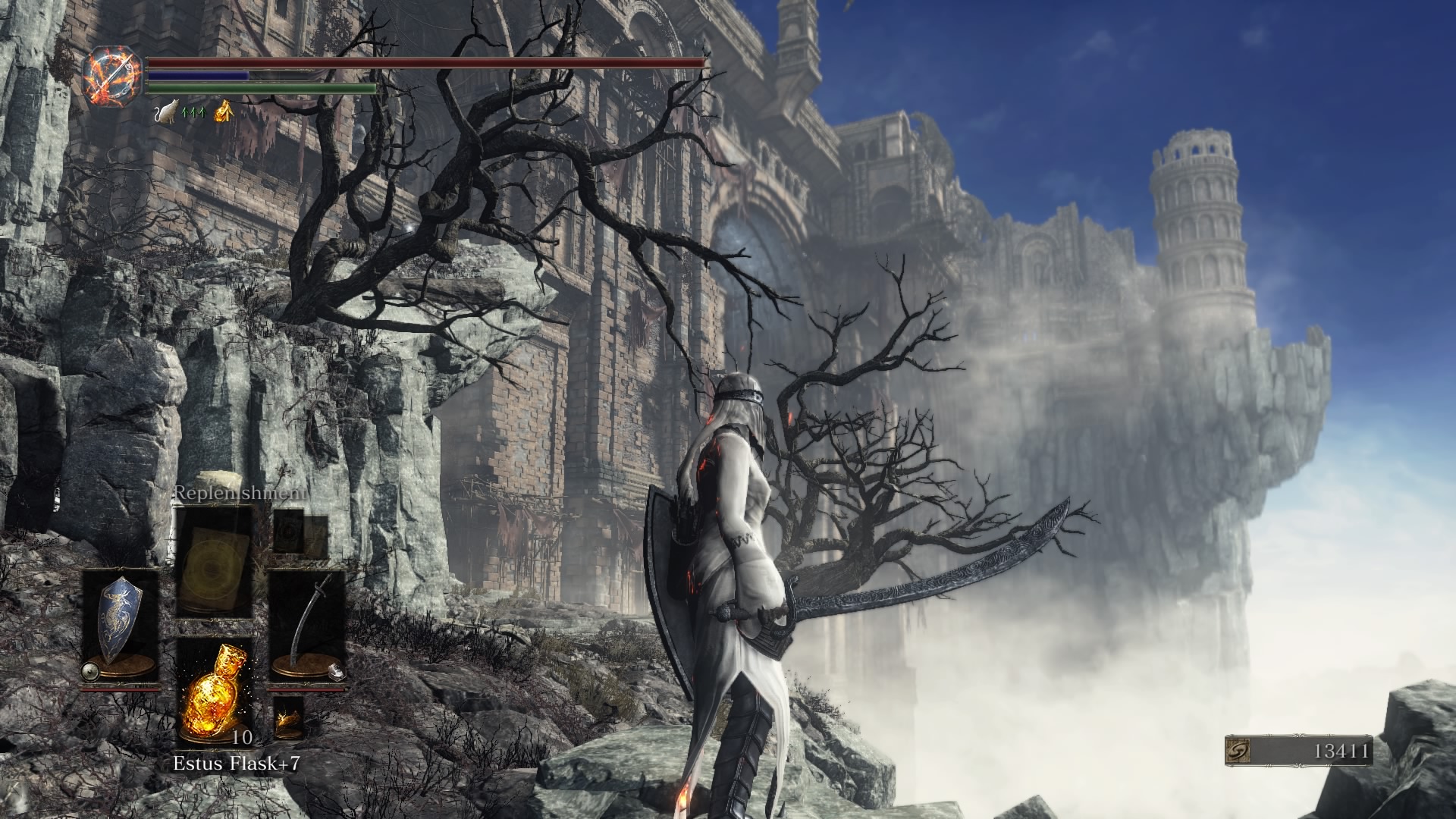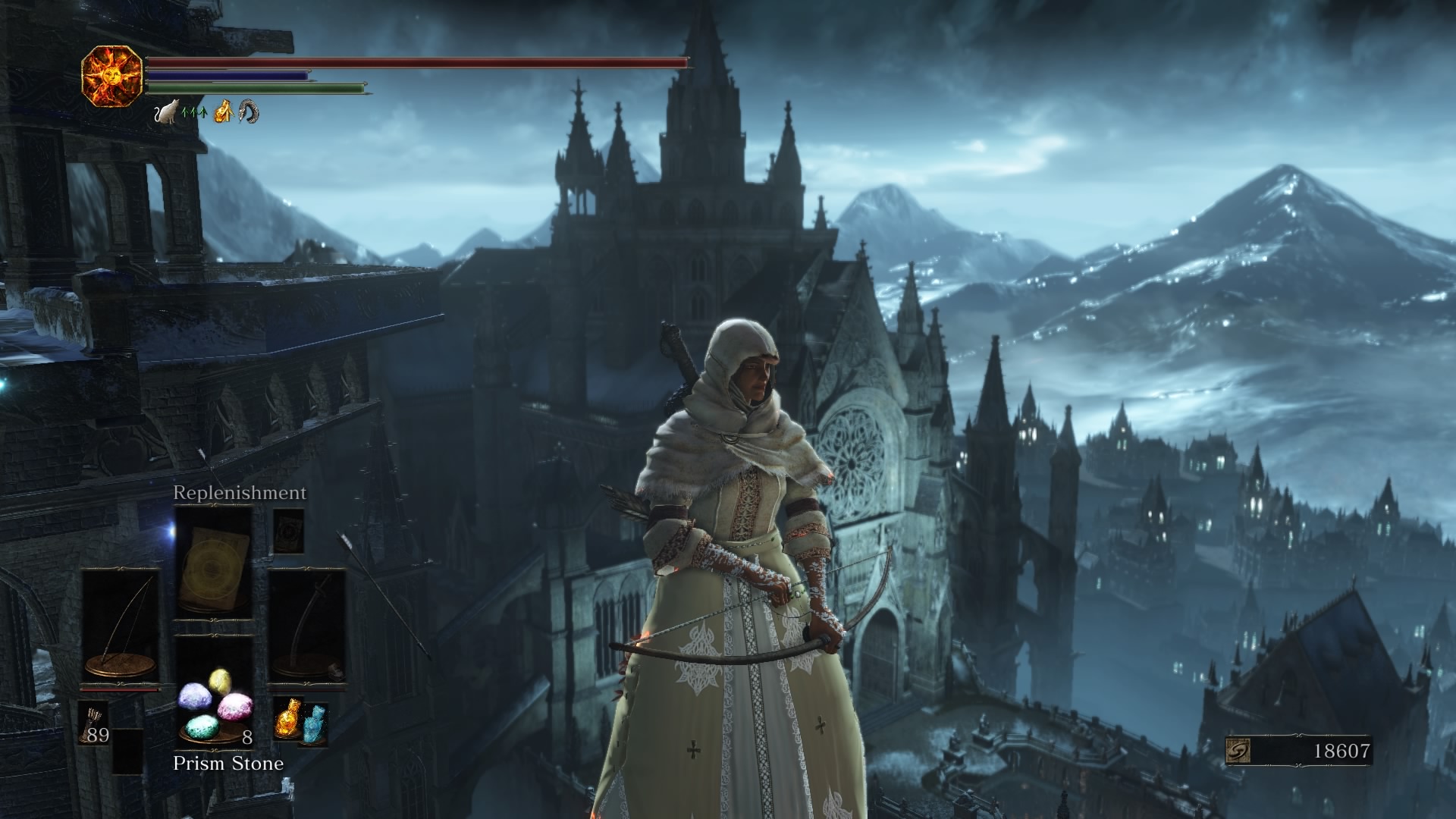Hey I Played a Video Game! Dark Souls III

And so the Souls series comes to an end (maybe. I’m not totally buying that From is abandoning this gravy train). This game felt a lot like a “Greatest Hits Remastered” collection of the whole series—which includes Demon’s Souls and Bloodborne as far as I’m concerned—so it’s appropriate that what I liked and disliked about it reflected my feelings on all of these games as a whole. But I did like this game quite a lot. As I’ve written before, these games scratch an itch that no other games I’ve played quite satisfy.
How Far I Got: Completed all of the main game content, including optional areas and bosses. Did a good amount of co-op and dipped my toes in PvP. Summoned other players for nearly every boss fight—I lose patience with Souls bosses very quickly—and I have no regrets. Have not tried any of the DLC. I might eventually, but right now I’m feeling like it’s time for a nice long break from Souls.
What I Liked: It’s a Souls game. Gorgeous art design? Check. A big mysterious world packed densely with dangers and secrets? Check. Painstakingly fine-tuned combat with a huge amount of variety? Check. There’s a reason I keep coming back to the series.
What I Disliked: It’s a Souls game. Frustration level can get unbearable? Check. Enemies seem to be cheating their way through level geometry and stamina constraints sometimes? Check. My build choice seems to get less effective as the game goes on for no clear reason? Check. There’s a reason that, no matter how many of these games I play, I always hesitate before buying a new one.
As much as I like the series, I’ve always had an uneasy relationship with the whole Prepare to Die™ ultra-hard reputation it has. I don’t normally like hard games. I only want enough challenge to keep me engaged in the experience, and I rarely complain about a game being too easy. I like when games make me feel incredibly competent, but I don’t care if it’s an actual reflection of my skill.
So Why Do I Play These Games At All? What really draws me into the Souls series is this: more than any other games I’ve played, they completely commit to the world they’ve created. They take basic meta aspects of games that were long taken for granted—being resurrected after dying, connecting to other players online, mastering segments of gameplay through repetition and memorization—and draw them directly into their story and themes. Because the games are punishing and their worlds are indifferent to the player’s presence, they can get away with hiding huge amounts of their content and giving only fleeting clues that the player is even missing anything.
This is the polar opposite of most games’ approach, and even after five entries I still find it exciting. A game like Skyrim will alert me when I pass a new dungeon, festoon my map with quest markers, and ensure that NPCs will just sit on their laurels until I stroll by to get their questlines moving again. Not only that, it won’t let me kill any character attached to a quest, even if I want to, just to ensure I will never ever miss any of the precious Content. There’s hundreds of hours of Content and I can save or restore my game at any point, but nope, the game just can’t take that risk.
In Dark Souls III I didn’t even meet half the characters. They were chasing their own goals, and my involvement was irrelevant. At one point I helped a woman from somewhere called the Sunless Realms kill her heavily-armored grandfather. Where are the Sunless Realms? Why did we need to kill her grandfather? She only gave me vague hints, and I had to fill in the gaps on my own.
I love this stuff. It’s so much simpler on a technical level than Bethesda games’ 24-hour character schedules, and yet it’s vastly more immersive. Most games feel like being a VIP customer at an amusement park, but these games are like sneaking under the rusted gate of an amusement park that was abandoned decades ago. It’s a lot more grueling, but the rewards you get feel so much more earned.
That said, I think that Miyazaki and From Software are skilled enough game designers to give players this experience without brutal, punishing difficulty. I’d really like to see them try that approach.

Favorite Areas:
- The Cemetery of Ash / Firelink Shrine. I still remember the Brown Age of video games: that period from roughly 2006 to 2011 when game designers thought they could lend weight and maturity to their experiences by turning the saturation way down, and usually ended up with tepid visual slop. This area, though? I think this is what they were trying to do. It’s a gorgeous use of grays and subtle brown tones that is oddly calming. It also shows off From’s mastery of rendering bumpy, uneven terrain in a way that feels organic, and creates a surprising amount of half-hidden little nooks.
- The Cathedral of the Deep. This is exactly the kind of multidimensional maze filled with unlockable shortcuts that the series excels at. This area constantly surprised me as I looped from the claustrophobic interior passageways to the cavernous nave to the treacherous paths along the rooftops and back again. It has a wide variety of enemies who can be gradually mastered as you learn to use the level geometry against them.
- Irithyll of the Boreal Valley. Not only did this help teach me what “boreal” means, it’s freaking gorgeous. I would visit a real city like this in a heartbeat (I’m assuming a real city would have more cafes and restaurants and fewer fireball-spewing bishops and giant rat monsters). I’m not as crazy about the enemies or the (for me) huge difficulty spike that this area presented, but at least it did offer a lot of new variety in the combat.
- Archdragon Peak. Blue sky? In a Souls game? What even is this? I love how much this area contrasts with the rest of the game. The enemies and environment present some interesting challenges (although I despise those snake-headed jerks with the two knives), but it’s the two boss setpieces and the vista of the enormous dead dragon that really do it for me. It’s all about grand spectacle, and I love it.

Least Favorite Areas:
- The Demon Ruins. This reminded me way too much of the chalice dungeons from Bloodborne—seemingly endless, repetitive hallways with no apparent purpose other than to be full of enemies. Did people supposedly live down here at some point? Were these rooms full of cubicles or something? It doesn’t tell a story, it’s not fun to traverse, it’s just a big maze full of annoying status-effect-spamming monsters.
- The Road of Sacrifices. A place with a name this cool should be much more interesting. Instead, it’s an incredibly short stretch of puke-colored woods with boring enemies. They might have a cool exploding-wing animation, but their movesets don’t make interesting use of the space. The NPC with the Butcher Knife was a more creative touch, but that’s about all this area has going for it.
- The Profaned Capital. Another great name, another wasted opportunity. I’m not the first person to note that this area probably suffered from a rushed schedule and cut content on From’s part. There’s barely anything here, and while it looks pretty cool and introduces us to the gargoyle enemies, it’s a far cry from the huge ruin I was expecting when I heard it described as a “capital.” A paltry reward for making it through the horrors of Irithyll Dungeon.
Favorite Bosses:
- Dancer of the Boreal Valley. This was not an easy fight for me, but the eerie beauty of the whole thing made up for the frustration. The music, the dancer’s deceptively slow and graceful movements, and the way the flames licked up the walls of the cathedral as the fight progressed were incredibly memorable and unlike any boss I faced in the preceding games.
- Ancient Wyvern. Small wonder that I would enjoy a boss fight that could have been pulled right out of Shadow of the Colossus. I can see how verteran players might have balked out how easy it was, but I liked that it shook up the usual formula, and that From had the restraint to allow me to kill it in one hit rather than make me run through the whole arena again while it was full of poison gas or something.
- The Nameless King. I mentioned before I like spectacle, and it doesn’t get much more over-the-top spectacular than this. This fight is basically like stepping into the cover of a killer heavy metal album from the 80s. It’s outrageously hard, but come on—it’s a battle against a storm god and his pet dragon-crow on top of a swirling mass of clouds. The challenge has to live up to that.
Least Favorite Bosses:
- Champion Gundyr. This jerk stepped over the boundary for me between “hard” and “oh, come on.” I think it was that stupid kick move. He’s incredibly fast, hard to read, and hits like a truck in every single direction. Having already fought him before doesn’t make the encounter meaningful or explain anything new about his character. Like the rest of the Untended Graves, he’s just a harder version of something we’ve already seen, and once that growing sense of familiarity is confirmed there’s not really much of a payoff.
-
Soul of Cinder. In isolation, this is a very well-designed final boss. It’s fast, it’s on your level rather than being a huge monster, and it tests your knowledge of every type of offense that the game’s enemies have offered up until this point. My problem with this fight is how it fits in the broader context of the series. It’s an obvious callback to the fight with Gwyn in the first game, but comes across as just a tougher and more involved remix of that same battle rather than something actually new. It also feels a lot like the fight with Gehrman at the end of Bloodborne, particularly the design of the arena. The way it regains its health at the halfway point would have been an interesting surprise if I hadn’t just seen the exact same thing happen in the Two Princes fight—and there, at least, it was justified by the presence of the second prince. Here, it’s unexplained, and just feels like the boss is cheating.
On top of that, it has none of the emotional weight of the Gwyn fight (or the King Vendrick fight for that matter), wherein you saw how far reduced a once-great being had become. There’s no buildup or explanation for what this weird fiery humanoid even is. It’s just a hard fight at the end of a hard game where the stakes of winning aren’t all that clear. I was underwhelmed.
How Does It Stack Up Against the Other Games? Honestly, it feels like a pure average of the whole series. It doesn’t really hit the same highs as the other games (largely because nearly every surprise here is recycled from them), but it avoids most of their low points. You could call it the quintessential Souls game: if you only play one, play this one. But watch the intro cinematic to the first Dark Souls first, because otherwise you’ll have no idea what “the fire fades” means or why that’s important.
Did I Sing “Shiny” from Moana Every Time I Saw One of Those Giant Crabs? Yes.